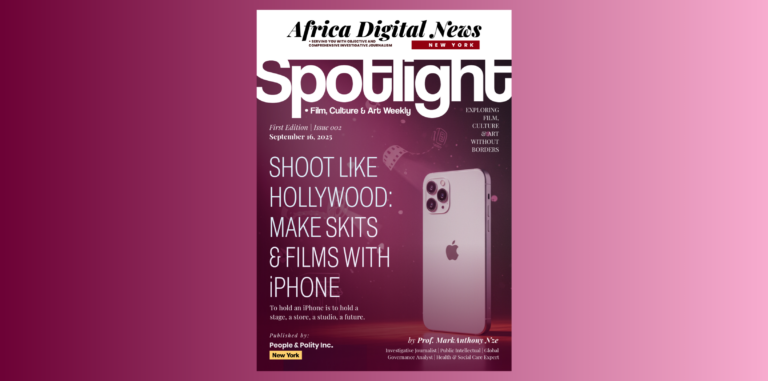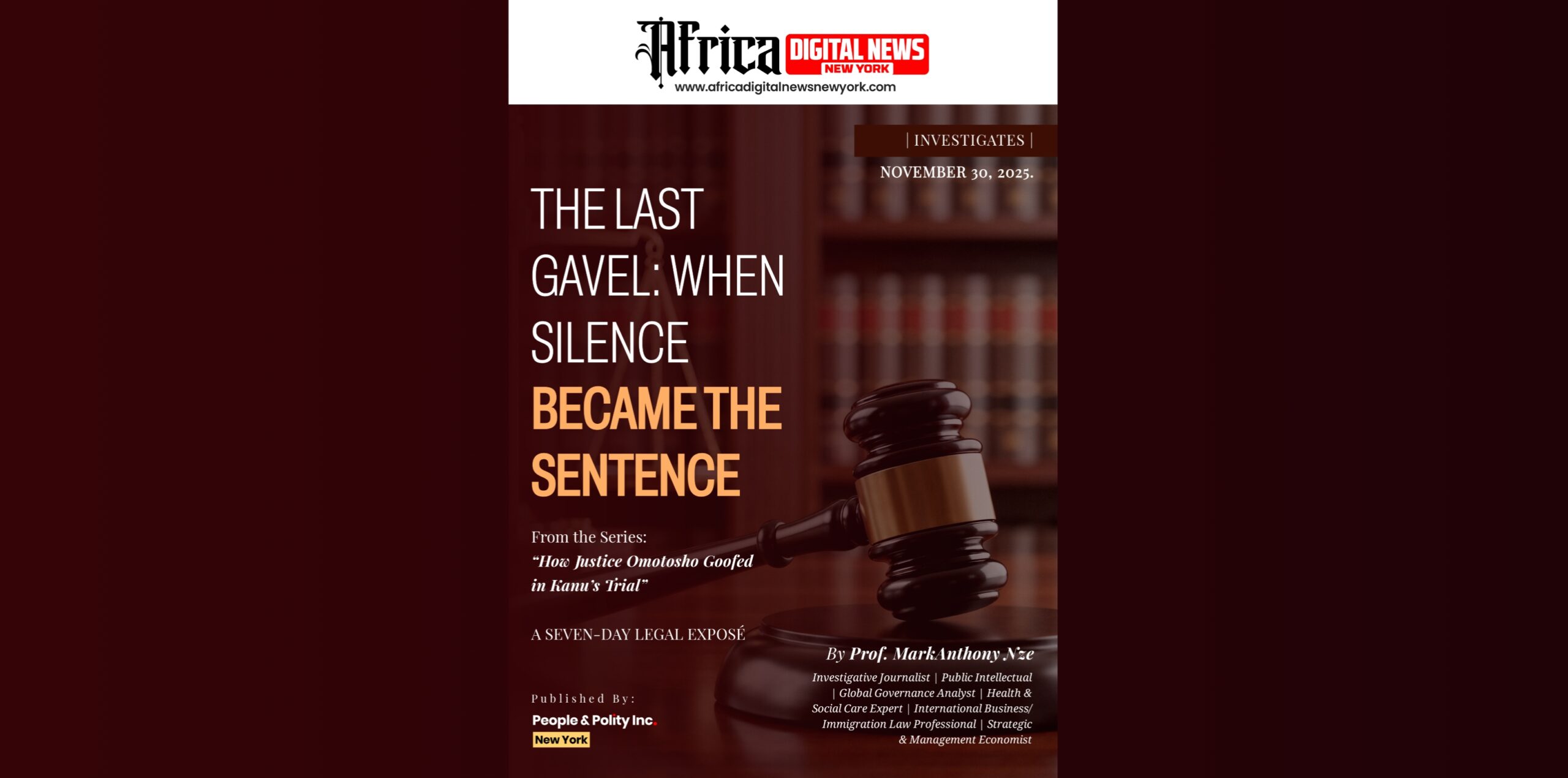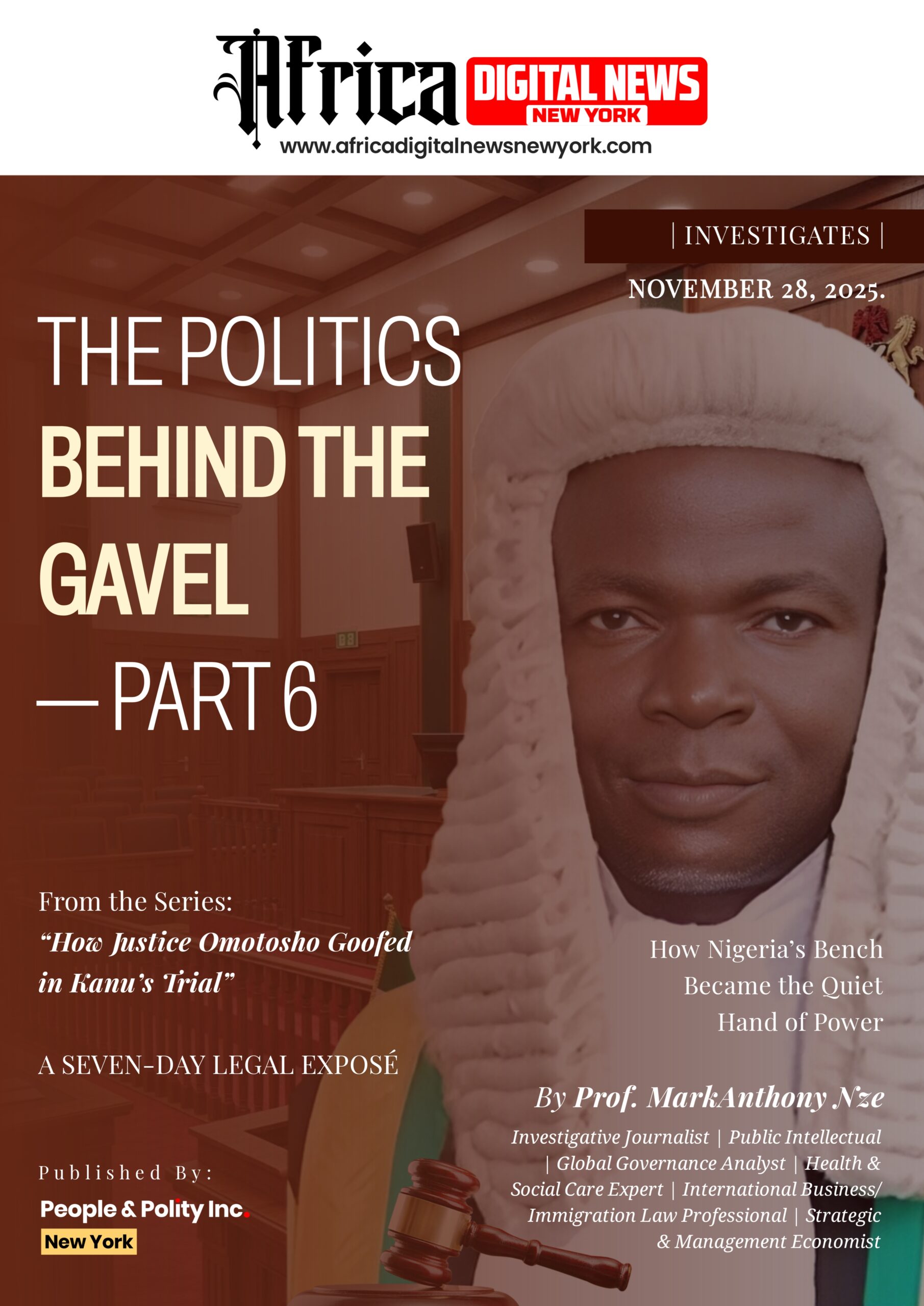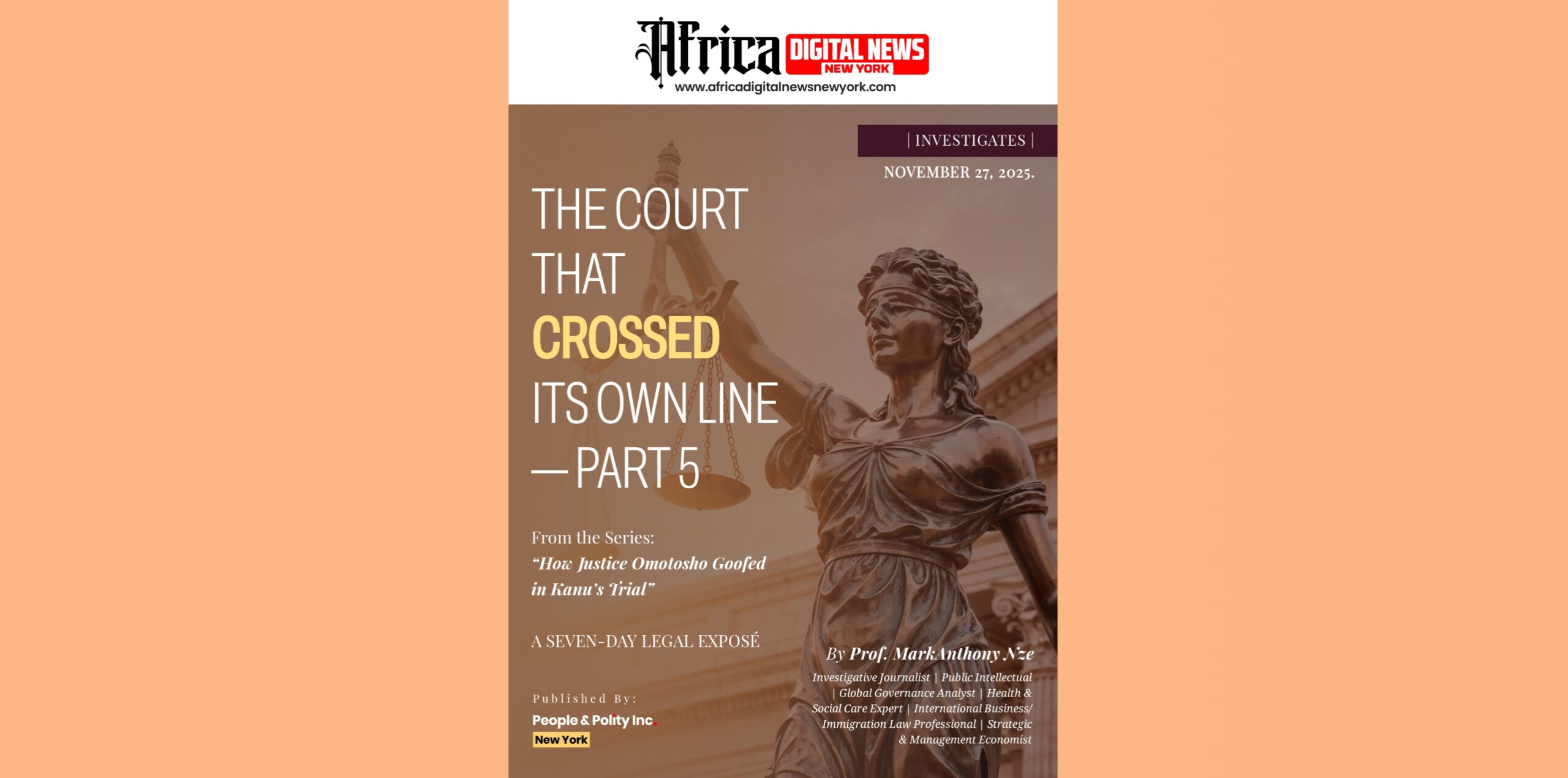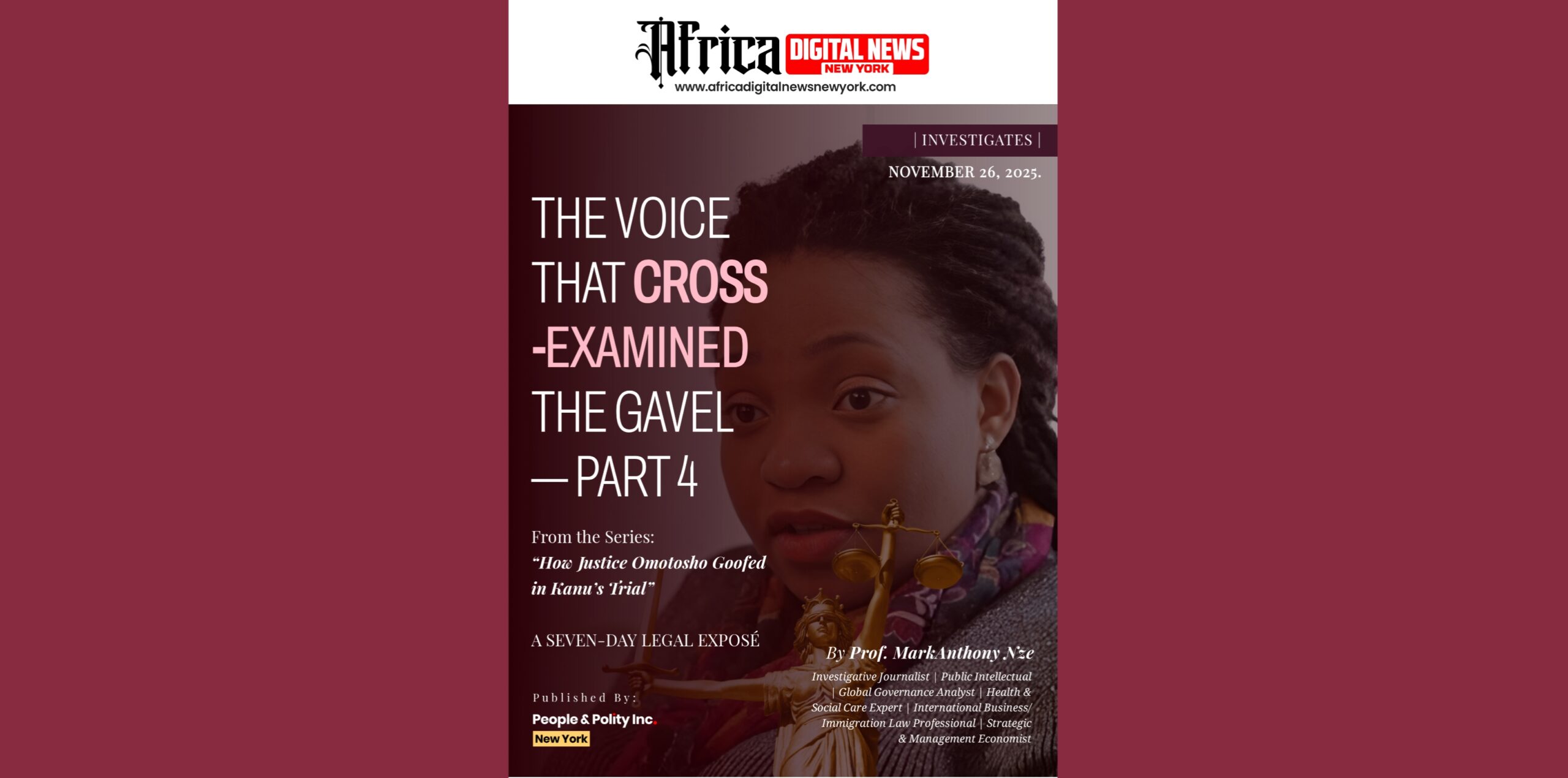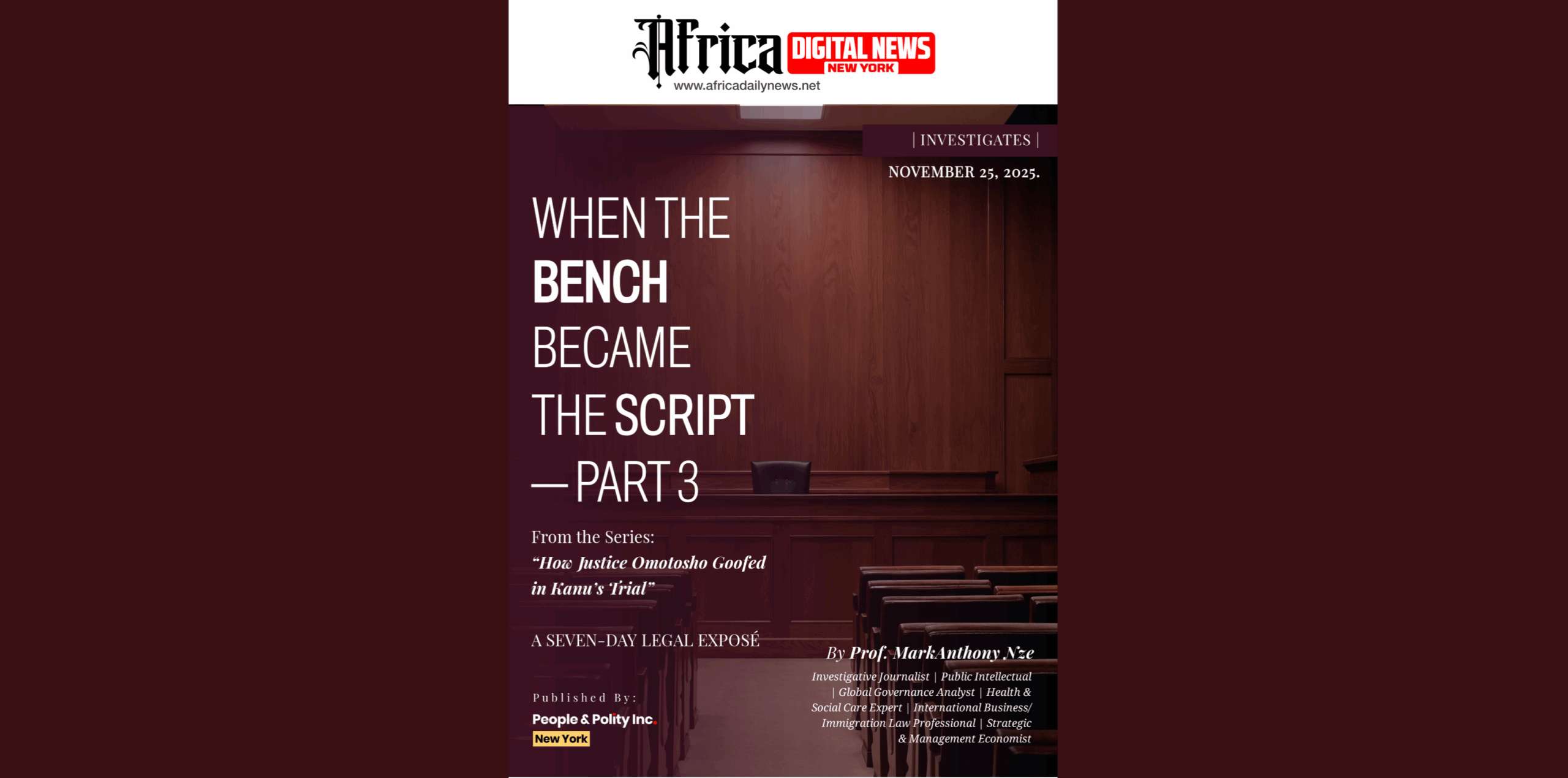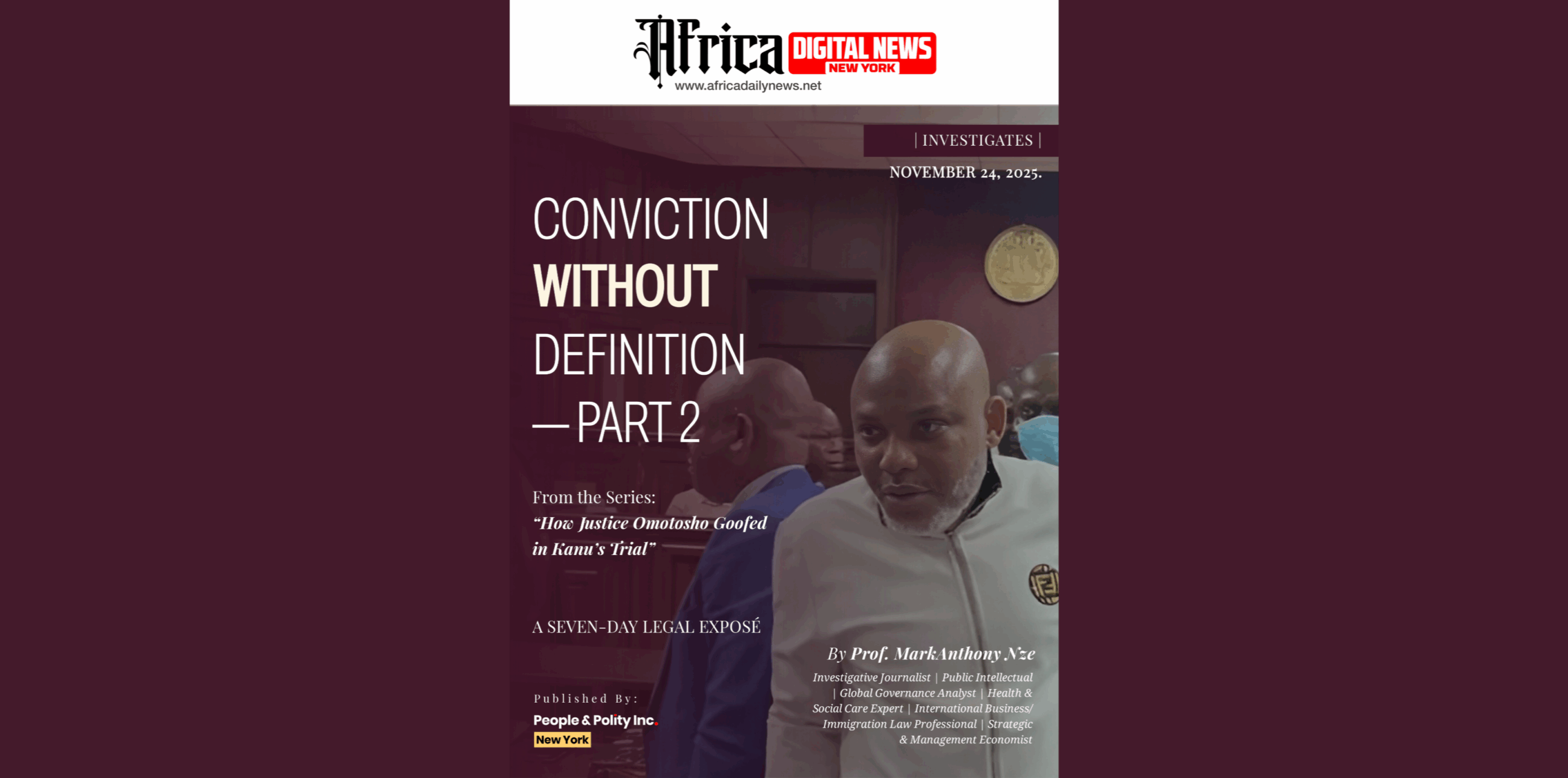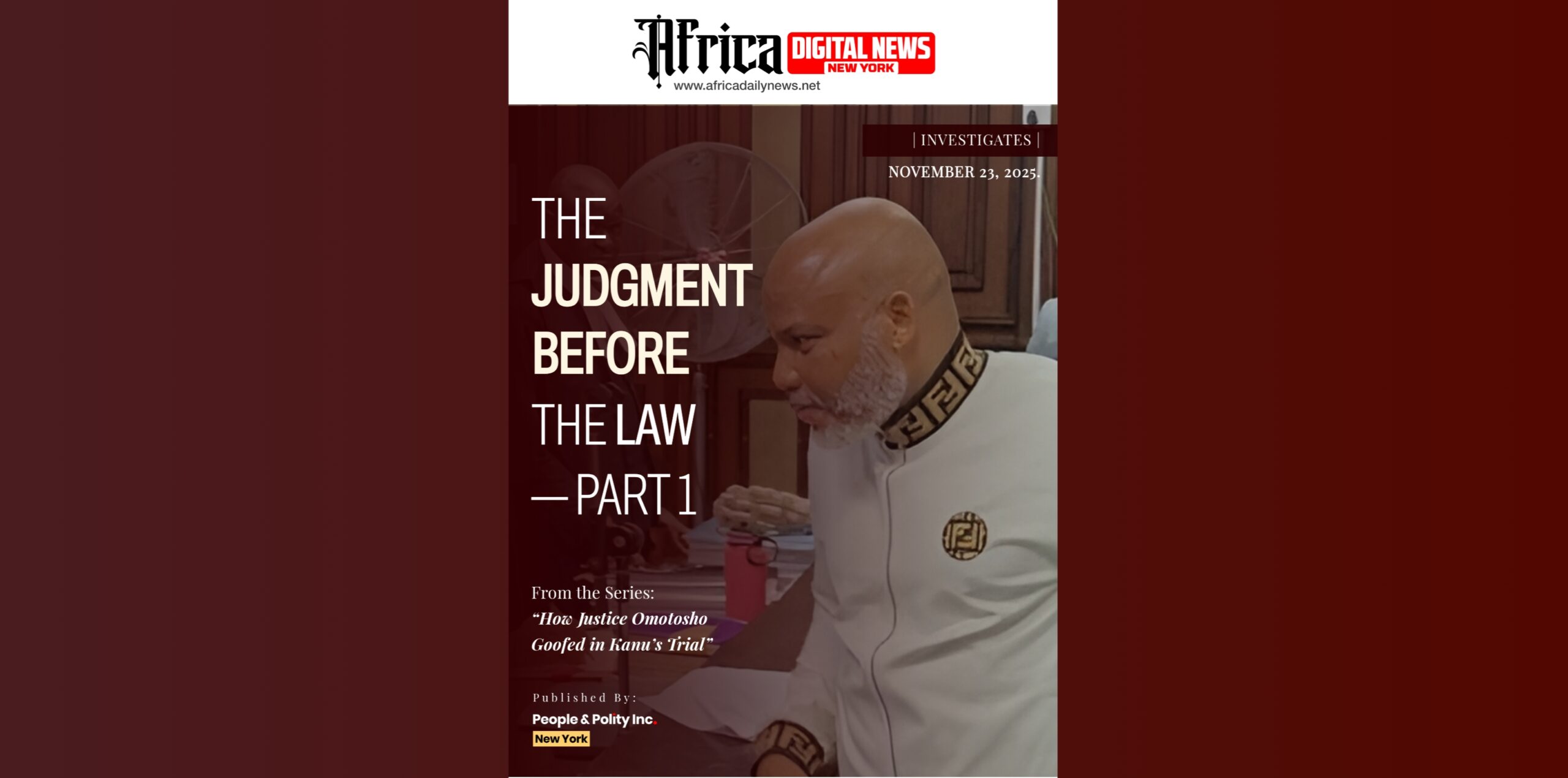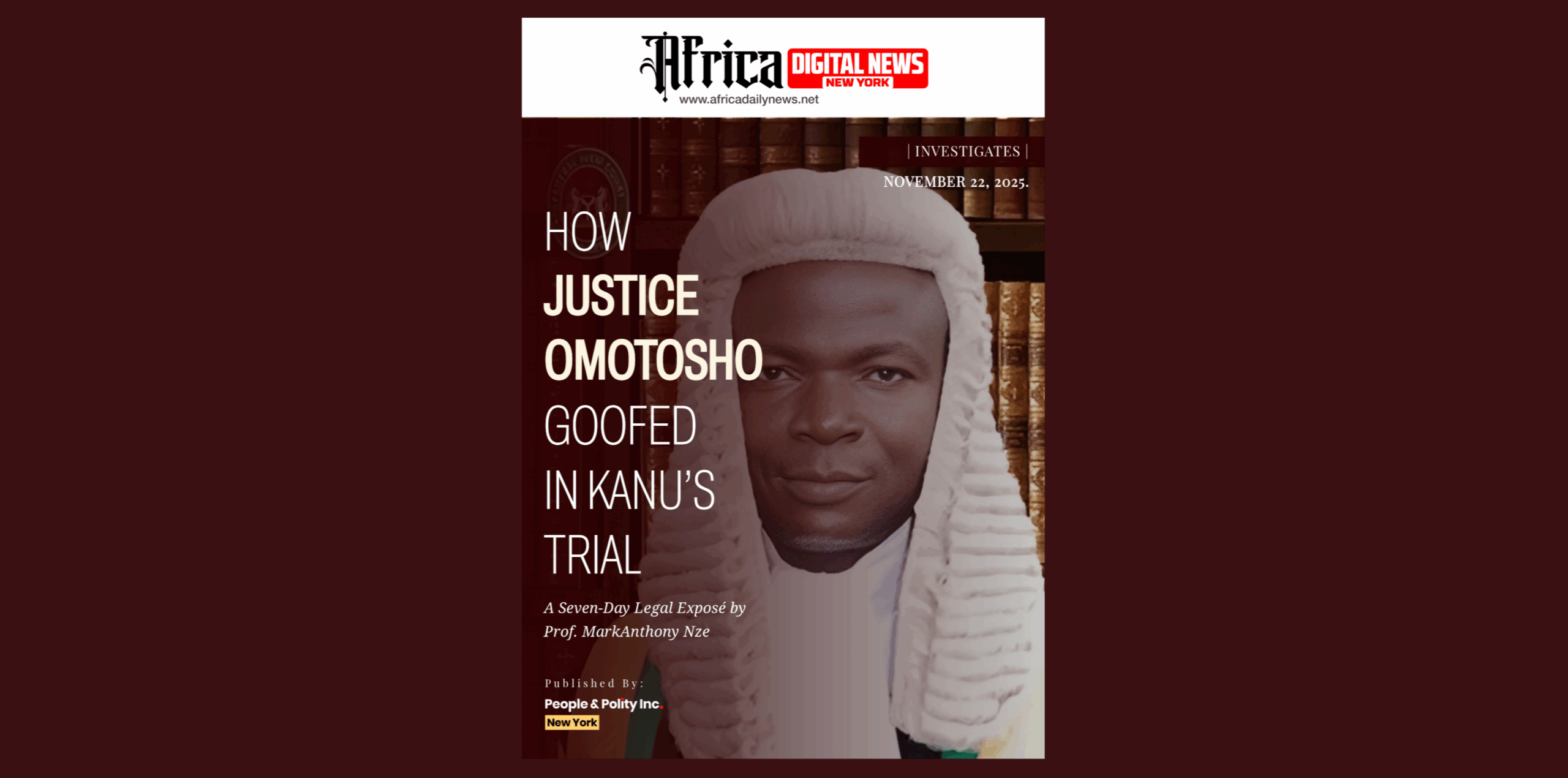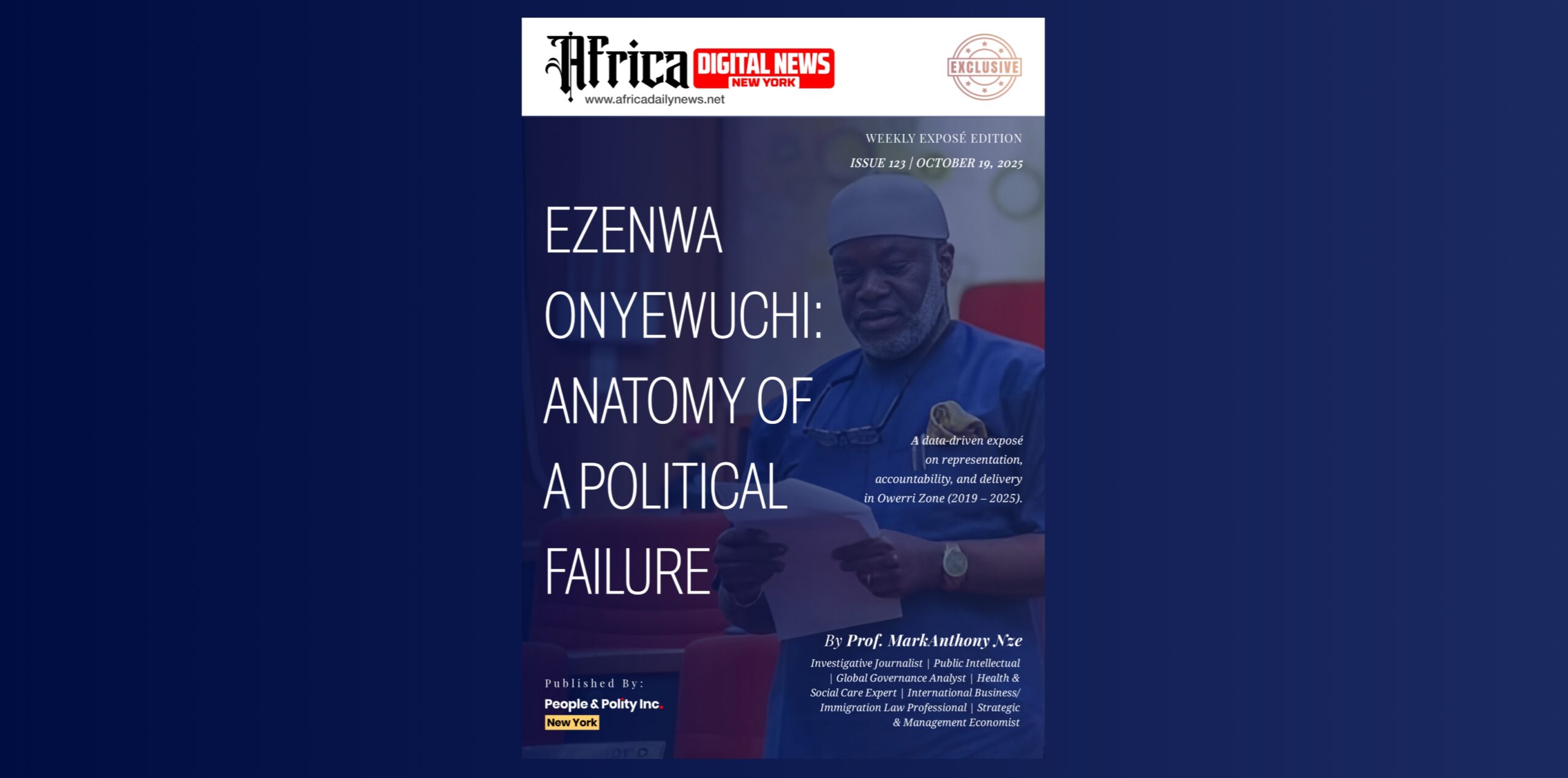Spotlight: Film, Culture & Art Weekly
Exploring Film, Culture & Art Without Borders
“To hold an iPhone is to hold a stage, a store, a studio, a future.”
By Prof. MarkAnthony Nze
Investigative Journalist | Public Intellectual | Global Governance Analyst | Health & Social Care Expert
Prologue: The Camera in Your Pocket
Cinema once belonged to the few. It required cranes, crews, studios, and budgets that dwarfed the dreams of ordinary people. Stories were filtered through institutions, controlled by financiers, and mediated by distributors. To create a film was to climb a mountain guarded by gatekeepers.
That age is over. The iPhone has turned the mountain into a sidewalk. Today, the same device that wakes you with alarms and carries your texts can also capture a commercial fit for global brands or a skit capable of millions of views before nightfall. What was once privilege has become possibility.
Yet democratization is not the same as mastery. The world is now flooded with video — shaky, noisy, forgettable. The difference between noise and narrative is not the sensor in the iPhone but the sensibility of the hand behind it. The craft remains: light must still be sculpted, sound must still be sharpened, stories must still be structured. Technology has lowered the cost of entry, but it has not abolished the grammar of cinema.
This series begins from a simple conviction: the iPhone is not a toy. It is the most revolutionary filmmaking tool of our century. But only if we learn to wield it. A 30-second skit can be more precise in its storytelling than a two-hour blockbuster. A micro-commercial shot in a bedroom can sell products more effectively than a multimillion-dollar ad. The barrier is no longer access; it is vision, discipline, and technique.
Here we will treat iPhone filmmaking as both a craft and a strategy. We will study light as language, angles as geometry, and sound as persuasion. We will explore how apps turn pocket devices into studios, how skits evolve into commercials, and how distribution transforms single videos into scalable businesses.
The point is not to imitate Hollywood but to reimagine what cinema can be when it is liberated from Hollywood. The camera in your pocket is not secondary to “real” cameras; it is the real camera of our time — the one that billions carry, the one that collapses the line between amateur and auteur, joke and ad, entertainment and economy.
This is not just about shooting video. It is about reclaiming the power to narrate, to persuade, to sell, and to dream — all from the palm of your hand.
Part 1: The Pocket Studio

Why your iPhone is a filmmaker’s secret weapon
A Revolution in Your Pocket
Not long ago, filmmaking was gated by equipment. To create a commercial or short film, you needed heavy cameras, lighting rigs, expensive lenses, and editing bays that cost more than the average car. Today, that monopoly has collapsed. What once required a studio can now be done from your pocket.
The iPhone is no longer just a phone. It is a pocket studio—a convergence of camera, sound recorder, editing suite, and distribution network in one device. For creators of skits, ads, and short films, this means the gap between idea and execution has narrowed to seconds. Inspiration no longer waits for permission; it waits for a swipe.
Consider this: entire feature films have been shot on iPhones and screened at international festivals. “Tangerine” (2015), filmed entirely on an iPhone 5s, premiered at Sundance and stunned critics with its raw energy. Steven Soderbergh’s thriller “Unsane” (2018), shot on an iPhone 7 Plus, was not a gimmick but a statement: mobile cameras had arrived as legitimate tools of cinema. If Hollywood veterans can turn a pocket camera into art, imagine what emerging creators can do with the iPhone 15 Pro Max in their hands.
For commercial skits and short-form ads, the stakes are even higher. Audiences don’t judge your equipment—they judge your story. Brands don’t ask whether you used a RED or an Arri Alexa; they ask whether the content stops thumbs from scrolling. And today, the iPhone is arguably the best thumb-stopper ever invented.
Democratizing Creativity
The genius of iPhone filmmaking lies in its democratization. Anyone can make a skit, but not everyone can make one that looks polished enough to sell a product or build a brand. The iPhone narrows that gap.
With built-in stabilization, HDR video, cinematic mode, and multi-lens systems, Apple has essentially collapsed professional gear into consumer form. A skit shot with an iPhone can now look indistinguishable from one shot with professional cameras—if the creator understands how to use light, composition, and sound. The barrier is no longer money. The barrier is skill.
This democratization matters in contexts where access to film schools, studios, and production budgets is scarce. In Lagos, Nairobi, Accra, or Johannesburg, young creators are building entire businesses off their iPhones, producing skits that attract millions of views and lucrative brand partnerships. The mobile phone is no longer just a communication device—it is Africa’s new film school, available in every pocket.
The Physics of Perception
Why does the iPhone succeed in filmmaking where older phones failed? The answer lies in the physics of perception. The iPhone camera is not technically superior to a $50,000 cinema rig—but it has evolved to exploit how the human eye and brain process images.
- Dynamic Range: iPhones use computational photography to capture multiple exposures at once and blend them. The result: skies retain their blue, shadows retain their depth. This mimics the way our eyes adjust to contrast in real time.
- Stabilization: Built-in optical and digital stabilization removes jitter, giving footage the smoothness audiences associate with professionalism. To the brain, stability signals intention.
- Frame Rates and Modes: Cinematic mode simulates depth of field, giving that blurred-background look once limited to expensive lenses. Slow-motion at 240fps transforms action into drama, while timelapse compresses hours into seconds. These are not gimmicks—they are storytelling devices.
- Audio-Visual Sync: The iPhone prioritizes clean audio capture and keeps sync tight, meaning dialogue rarely feels “off.” For skits, where timing is comedy’s oxygen, this is gold.
By aligning with perception rather than raw resolution, iPhones create footage that feels cinematic even when the technical specs lag behind high-end rigs. It’s less about engineering and more about psychology.
From Idea to Execution in Seconds
Filmmaking has always been slowed by logistics: setting up gear, hiring crews, booking spaces. With an iPhone, execution is instant. Got a skit idea while commuting? Pull out your phone, shoot, edit in LumaFusion or CapCut, and upload before you get home. The immediacy of mobile filmmaking is not just convenience—it’s creative momentum.
Many viral skits succeed not because they are perfectly polished, but because they feel alive, unfiltered, urgent. The iPhone allows creators to capture that urgency without sacrificing too much quality. In the attention economy, speed is often more valuable than perfection.
This agility is why brands are now commissioning iPhone-shot content. In fast-moving markets, where trends flip weekly, companies no longer want six-month production cycles. They want content yesterday. Creators who can ideate, shoot, and deliver high-quality ads in days—using nothing more than a phone—are indispensable.
The Pocket Studio Mindset
To unlock the iPhone’s full potential, creators must shift mindset: stop seeing it as a phone with a camera, and start seeing it as a studio condensed into glass and metal.
Think of the iPhone in layers:
- Camera = Director of Photography
- Mic Input = Sound Engineer
- Editing Apps = Post-Production Suite
- Storage/Cloud = Film Archive
- Social Platforms = Global Distribution
Once you recognize this, your pocket no longer holds a gadget—it holds an entire production company.
This shift in mindset changes behavior. You no longer wait for conditions to be perfect; you learn to capture with what you have. You no longer worry about lacking a studio; you realize the world is your studio. That park bench, that corner shop, that rooftop—all become sets. The iPhone does not shrink creativity; it expands it by eliminating excuses.
Case Study: Skits as Brand Catalysts
Take the example of Nigerian comedy skits on Instagram and TikTok. Many of these creators began with nothing but iPhones. Through consistent short-form content—often improvised, often shot in living rooms—they built millions of followers. Brands noticed. Suddenly, 60-second skits about everyday struggles became platforms for product placement, sponsored storytelling, and full-fledged ad campaigns.
The formula is simple but profound:
- Relatable story
- Quick setup and punchline
- Subtle brand integration
- Crisp iPhone visuals
Audiences consume the skit as entertainment, not advertisement. The brand gains visibility through culture, not coercion. And the creator earns income, reputation, and leverage—all from a pocket studio.
Limitations as Creativity Engines
Of course, the iPhone is not limitless. Low light remains tricky, zoom cannot compete with professional lenses, and sensors are smaller than cinema cameras. But here’s the paradox: limitations often drive creativity.
When you cannot rely on zoom, you move closer—creating intimacy. When low light hinders, you innovate with practical lighting—lamps, candles, neon signs. When you lack multiple lenses, you plan shots more carefully. In filmmaking, constraint is often the mother of style.
Great creators embrace these boundaries, turning them into signatures. Just as Dogme 95 filmmakers once stripped cinema to handheld cameras and natural light, today’s iPhone creators find authenticity in rawness. What was once considered a flaw—grain, handheld shake, imperfect light—becomes aesthetic.
Why It Matters Now
We live in an attention economy. The scarcest resource is not money or equipment—it is focus. The iPhone is the most direct bridge between idea and audience, collapsing every step between conception and consumption.
- Traditional filmmaking = idea → pitch → funding → crew → gear → shoot → edit → distribute.
- iPhone filmmaking = idea → shoot → edit → publish.
This collapse is not trivial. It redefines who gets to tell stories, who gets to sell products, who gets to influence culture. By lowering entry barriers, the iPhone ensures that stories once locked out of boardrooms now reach millions.
And in this collapse lies the most radical promise: that the next great filmmaker, the next iconic skit, the next viral ad campaign will not come from Hollywood studios or Madison Avenue agencies. It will come from someone with an iPhone, an idea, and the courage to hit record.
Conclusion: The Studio Is You
The iPhone as pocket studio is not just about technology—it is about liberation. It liberates creators from permission, from gatekeepers, from the tyranny of expensive gear. It empowers anyone, anywhere, to transform imagination into moving images that can entertain, persuade, and sell.
The question is not whether the iPhone is capable—it is whether creators are willing to see it as more than a phone. Because in the end, filmmaking has never been about equipment. It has always been about vision. The iPhone simply makes vision executable at scale.
So the next time an idea for a skit or ad flashes into your mind, remember: the studio is already in your pocket. The world doesn’t care what camera you use. It cares whether you tell the story well enough to make them stop scrolling.
Part 2: Lights, Angles, Action

Mastering the basics of framing and lighting on mobile
The Language of Images
Every image tells a story before a single word is spoken. In film, story is shaped as much by light and angles as by dialogue or performance. A punchline lands harder if framed correctly. A product looks luxurious if lit with intention. Even a 30-second skit depends not only on actors but on the invisible grammar of cinema: where the camera stands, where the shadows fall, how the viewer’s eye is guided.
With iPhone filmmaking, this grammar doesn’t disappear. If anything, it becomes more critical. The iPhone camera is powerful, but it is not magic. Its true strength lies in the hands of the creator who understands how to wield the oldest cinematic tools: light and perspective.
Light: The First Brushstroke
Filmmakers often say that cinema is “painting with light.” Without light, the camera sees nothing. With bad light, even the best story looks amateurish. Good lighting is not about expense—it is about control.
- Natural Light as Free Studio
- Sunlight is the most powerful tool a creator has, and it’s free. Morning and late afternoon (“golden hour”) create soft, warm light that flatters faces and adds emotional depth. Noon light, by contrast, casts harsh shadows—perfect for satire or exaggeration, less ideal for beauty shots.
- Window light can turn an ordinary room into a set. Place your subject facing the window, not with their back to it. Suddenly, your iPhone captures softness rivaling professional rigs.
- Practical Light: Everyday Props
- Lamps, candles, computer screens, even neon signs can serve as lighting tools. In fact, these “practicals” add realism to skits, grounding comedy or drama in everyday spaces.
- For commercials, practicals can highlight products: a lamp angled at a shoe, a candle flickering beside a drink, a smartphone glowing in darkness.
- Ring Lights and LED Panels
- Affordable LED lights have collapsed the distance between amateur and professional. A $30 ring light can remove shadows and give eyes that signature sparkle. Mini LED panels, powered by USB, can simulate studio setups on a budget.
- The key is not intensity but placement. Light from above flattens, light from below dramatizes, light from the side sculpts. Every angle alters the emotional tone.
The iPhone camera, with its computational wizardry, thrives in good light but struggles in poor light. Give it illumination, and it rewards you with cinematic clarity. Starve it, and even its algorithms cannot save you.
Angles: The Geometry of Emotion
If light is painting, angles are geometry. Where you place the iPhone determines how the audience feels about the subject.
- Eye Level = Equality
Shooting at eye level makes the subject relatable. For comedy skits, this is often the best default: the audience feels they are in on the joke, not watching from above or below. - High Angle = Vulnerability
Tilt the camera down, and the subject appears smaller, weaker, less in control. This is perfect for skits mocking failure, embarrassment, or powerlessness. - Low Angle = Power
Shoot upward, and the subject looms. Politicians, villains, or products can all benefit from this angle—it signals dominance. A soda can shot from low angle suddenly looks monumental. - Close-Up = Intimacy
The closer the lens, the more detail and emotion are revealed. Comedy often lives in close-ups: the raised eyebrow, the awkward pause, the micro-expression. Commercials, too, depend on close-ups—whether of a smiling face or a product label. - Wide Shot = Context
Step back, and the scene tells its own story. For skits, a wide shot can exaggerate emptiness or highlight a character’s isolation. For ads, it situates the product in lifestyle—showing not just an object but the world it inhabits.
Angles are not random. They are deliberate choices that guide emotion. Every tilt of the iPhone is a sentence in the visual script.
Framing: The Art of What You Show
Beyond angle, framing decides what enters the rectangle. Framing is not passive—it is power.
- Rule of Thirds: Divide the screen into a grid of nine. Place subjects at the intersections. This creates balance and energy, avoiding the stiffness of dead-center framing.
- Headroom and Lead Room: Leave space above the head and in the direction the subject faces. Cutting too close feels claustrophobic unless that is your intent.
- Foreground/Background: Layers add depth. Place objects in the foreground (a chair, a plant) to frame the subject. This creates dimension that tricks the eye into reading iPhone footage as cinematic.
- Symmetry vs. Asymmetry: Centering can feel powerful (Wes Anderson’s style), while asymmetry feels dynamic. The choice signals tone.
A well-framed shot can elevate even a simple skit. A poorly framed one can make a high-budget ad look cheap. The rectangle is the stage; filling it wisely is the filmmaker’s craft.
Movement: The Invisible Hand
The iPhone, light as it is, invites movement. But motion must serve story, not distract.
- Static Shots: Comedy often thrives on stillness. A locked-off camera lets action unfold without interference.
- Panning and Tilting: Slow pans can reveal punchlines; quick pans (“whip pans”) can add comedic timing.
- Tracking: Walking with your subject, iPhone in hand, creates intimacy—placing the viewer inside the action.
- Stabilizers: Affordable gimbals (like DJI Osmo Mobile) turn handheld shots into buttery smooth sequences, perfect for commercials.
Remember: the iPhone democratizes movement, but discipline separates amateurs from filmmakers. Move with intention.
Case Study: Lighting the Punchline
Picture a skit: a character sneaks into a fridge at midnight.
- Lit only by the fridge’s interior light, the face glows ghostly.
- A low angle from inside the fridge frames the action as absurd and slightly sinister.
- When the door shuts, darkness drops—the punchline lands.
This entire setup requires no more than an iPhone and a refrigerator. Yet with light, angle, and framing, it becomes cinematic comedy.
Commercial Application: Selling Through Style
Consider a 15-second ad for a skincare brand.
- Natural morning light streams through a window, backlighting the product bottle.
- The iPhone, low-angled and close, captures condensation glistening on the surface.
- A slow tilt upward reveals a smiling face applying the cream, framed in thirds.
- Cut to a wide shot: the subject by the window, bathed in golden glow, serenity implied.
This sequence costs nothing in gear but communicates luxury and trustworthiness—exactly what the brand pays for. The iPhone is not just tool; it is amplifier of craft.
The Myth of “Good Enough”
Many assume iPhone filmmaking is “good enough” but not professional. This is false. The gap between “good enough” and “professional” is not the camera—it is the mastery of light and angle.
An unlit, poorly framed iPhone video screams amateur. A well-lit, carefully framed one can rival commercials shot with cameras costing fifty times more. Viewers cannot always articulate why something looks professional, but they can feel it. That feeling is generated by fundamentals, not budget.
Practical Tips: The iPhone Creator’s Toolkit
- Always carry a foldable reflector (or use a white sheet of paper) to bounce light.
- Use grid overlays on your iPhone to apply rule of thirds.
- Practice framing by watching your favorite films—pause and study angles.
- Remember: light the face, frame the eyes, and let story dictate movement.
Conclusion: Craft Over Gear
The secret to cinematic iPhone filmmaking is not hidden in apps or expensive accessories. It lies in the discipline of seeing—seeing how light sculpts, how angles persuade, how framing narrates. With mastery of these fundamentals, an iPhone ceases to be a phone and becomes a brush, a compass, a pen of moving images.
Great filmmaking has always been less about the machine and more about the mind behind it. The iPhone has removed excuses. What remains is vision, discipline, and the courage to aim the lens.
In the end, “Lights, Angles, Action” is not just a call to shoot. It is a reminder that even in a world where technology evolves every year, the fundamentals of cinema remain timeless. And with an iPhone, those fundamentals are finally within everyone’s reach.
Read also: Twin Flames of Afrobeats: The World Still Wants P-Square
Part 3: Sound Makes the Scene

Viewers forgive shaky video, never bad audio.
The Silent Lie of Cinema
There is a paradox at the heart of filmmaking: movies are a visual medium, yet sound carries the weight of believability. Strip away the soundtrack from your favorite skit, commercial, or film, and suddenly the magic collapses. Even shaky visuals can feel raw and authentic, but poor audio feels unwatchable.
Audiences don’t articulate this consciously. They may say, “the video looks bad,” when what they mean is that the sound is muddy, tinny, or drowned in background noise. The ear is ruthless. It demands clarity, texture, and presence.
For iPhone creators, this lesson is essential: master sound, and your skits or commercials will leap from amateur to professional instantly.
Why Sound Matters More Than You Think
- Emotion Lives in Sound
- Dialogue delivers humor, drama, or persuasion. If muffled, the joke dies and the ad fails.
- Music dictates mood. A beat drop can elevate a punchline; a subtle underscore can make a product feel aspirational.
- Sound Creates Space
- Good audio captures not only voices but environments: the café hum, the footsteps on pavement, the rustle of clothing. These cues trick the brain into inhabiting the scene.
- Sound Builds Trust
- In commercials, crisp audio signals professionalism. A beauty brand ad with distorted sound feels cheap, no matter how perfect the lighting. Trust is built through sonic polish.
This is why seasoned filmmakers often insist: if you have to choose between better camera or better sound, invest in sound first.
The Limits of Built-In iPhone Mics
Apple has invested heavily in camera evolution, but the microphone remains a compromise. Built-in mics are fine for casual use but weak for professional filmmaking because:
- Proximity Issues: They capture everything around equally. Dialogue loses intimacy.
- Noise Sensitivity: Traffic, fans, wind—all dominate.
- Lack of Directionality: Built-ins cannot focus on one voice while ignoring background.
This does not mean the iPhone is doomed. It means creators must treat audio as a discipline, just as they treat lighting and framing.
The Golden Rule: Mic Closer Than Camera
The simplest audio law is this: your microphone should always be closer to the subject than your camera.
If you film a skit 10 feet away, the video looks fine, but the sound feels distant. Solution: use external mics. They are the cheapest way to elevate production value.
Essential iPhone Audio Tools
- Lavalier Mics (Clip-On Microphones)
- Best for skits with dialogue. Clip discreetly on shirts or collars.
- Affordable models ($20–$50) work wonders; pro-grade lavs (RØDE SmartLav+, Sennheiser) give broadcast quality.
- Plug directly into Lightning/USB-C or connect wirelessly.
- Shotgun Mics
- Directional mics that “point” at sound. Perfect for commercials where you want focus on one product demo or line of dialogue.
- Compact versions (RØDE VideoMic Me, Shure MV88+) attach directly to iPhones.
- Handheld Recorders
- Zoom H1n or Tascam recorders capture high-quality sound separately. Sync later in editing.
- Overkill for skits, but gold for commercials where detail matters.
- Wireless Systems
- Creators now swear by RØDE Wireless Go or DJI Mic—tiny transmitters that clip to talent and send audio directly to the iPhone.
- Perfect for dynamic skits, moving shots, or outdoor ads.
The Enemy: Background Noise
Noise ruins skits faster than bad acting. The iPhone mic hears refrigerators, AC units, distant cars—everything. Solutions:
- Choose Locations Wisely: Quiet rooms, early mornings, or isolated spaces.
- Turn Off Machines: Fans, ACs, TVs—kill them before recording.
- Use Deadcats/Windscreens: Furry covers block wind when filming outdoors.
- Noise Reduction in Apps: Tools like Ferrite, Adobe Podcast Enhance, or LumaFusion filters clean audio after capture.
The rule: prevent noise before recording; fix it only as last resort.
Layering Sound: Beyond Dialogue
Professional films and ads always layer three kinds of sound:
- Dialogue – Clear, intimate, properly miked.
- Foley – Recreated everyday sounds: doors closing, footsteps, paper rustling. Even in skits, adding these sharpens realism.
- Music/Score – The emotional driver. Sets pacing, mood, and brand tone.
Example: In a 30-second skincare ad shot on iPhone:
- Dialogue explains product benefit.
- Foley captures the cap twisting open, cream applied.
- Music sets aspirational tone.
The layering transforms the ad from homemade to cinematic.
The Role of Silence
Silence is not absence—it is texture. Used well, it amplifies tension or comedy.
- In a skit: the pause before a punchline, filled with nothing but awkward silence, creates laughter.
- In an ad: silence before a slogan drop makes the brand message hit harder.
iPhone filmmakers must resist the urge to fill every second with noise. Trust silence as narrative.
Editing Sound Like a Professional
Shooting is half the battle. Editing audio matters as much. iPhone apps now rival desktop software.
- LumaFusion – Professional-grade video editor with robust audio tools: EQ, compression, mixing tracks.
- Ferrite – Designed for podcasts, perfect for dialogue cleanup.
- CapCut – Accessible, free, with simple music and sound layering.
- Adobe Audition (desktop) – For advanced sound design, but requires export.
Key editing techniques:
- Normalize audio so dialogue is consistent across scenes.
- EQ (equalization) to brighten voices and cut low rumble.
- Add room tone (a subtle background hum) to glue edits together.
The difference between “student project” and “professional commercial” is often not the visuals but the sound mix.
Case Study: Comedy Skit
Imagine a simple iPhone skit: a student sneaks snacks during class.
- Audio of classroom murmur sets the scene.
- The crinkle of the snack wrapper (foley) builds suspense.
- Teacher’s voice enters, crisp and sharp.
- The moment of silence before punchline amplifies comedy.
- A beat of laughter, then outro music.
Without this layering, the skit feels flat. With it, the same visuals feel alive, immersive, and professional.
Case Study: Commercial Spot
Now imagine a 20-second iPhone-shot ad for coffee.
- Opening: Sound of beans grinding, layered with light jazz.
- Middle: Pouring coffee captured in crisp stereo, steam hissing.
- Ending: A sip, silence, then voiceover: “Awaken your day.”
Shot on iPhone, but with layered sound, it becomes indistinguishable from global campaigns.
DIY Sound Hacks for iPhone Filmmakers
- Record foley separately with your iPhone’s Voice Memos app in quiet spaces.
- Use pillows or blankets to create makeshift soundproof booths.
- For echoey rooms, hang curtains or shoot inside closets for cleaner audio.
- Don’t underestimate royalty-free sound libraries; many are free.
Creativity matters more than gear.
The Philosophy of Sound in Storytelling
Great sound is invisible. Viewers never notice it when it’s good, only when it fails. Yet for filmmakers, treating sound as afterthought is fatal.
- Comedy = timing, and timing is sonic.
- Drama = atmosphere, and atmosphere is sonic.
- Advertising = persuasion, and persuasion is sonic (tone of voice, clarity, resonance).
In the attention economy, where audiences swipe within three seconds, sound is the hook. A crisp first word or catchy beat makes the difference between scrolling past or staying.
The Future: Spatial and Immersive Audio
Apple is betting big on spatial audio. AirPods already simulate 3D soundscapes; iPhones can record binaural audio. For creators, this means immersive experiences: skits where voices surround you, commercials where sound feels tactile.
Early adopters will stand out. A creator who layers spatial sound into iPhone skits will instantly feel ahead of the curve, delivering experiences traditional ad agencies can’t replicate cheaply.
Conclusion: The Ear Rules the Eye
The iPhone has democratized filmmaking, but without sound mastery, even the sharpest video falls flat. Audio is not accessory—it is essence.
Creators who learn to capture clean dialogue, suppress noise, layer music and foley, and use silence strategically will outpace competitors. Skits will feel sharper. Commercials will build trust. And most importantly, audiences will stay.
The lesson is simple but profound: the ear rules the eye. Viewers may forgive a shaky shot, but they will never forgive bad sound. Master audio, and your iPhone becomes not just a pocket studio—but a soundstage of persuasion.
Part 4: Apps That Turn You Pro

The software toolkit every iPhone filmmaker needs.
The New Studio Is in Your Pocket
A generation ago, filmmakers needed entire studios: editing suites with racks of equipment, color-grading stations, soundproof booths. Today, an iPhone plus the right apps can rival those multimillion-dollar setups. What was once inaccessible to all but Hollywood insiders is now democratized.
Yet this power hides in plain sight. The iPhone’s default Camera and iMovie apps are impressive, but they barely scratch the surface. The true leap from amateur to professional comes when you unlock specialized apps that give control over filming, editing, sound, and finishing.
Apps are the new lenses, the new lighting rigs, the new mixing boards. They are the invisible infrastructure behind viral skits, cinematic ads, and even indie films premiering at festivals. To master iPhone filmmaking, you must master the apps.
Filming Apps: Taking Control of the Lens
The iPhone’s built-in Camera app is powerful but automated. For casual users, that’s perfect. For filmmakers, automation is a prison. Exposure shifts mid-shot, focus drifts, white balance changes. To shoot like a pro, you need manual control.
- FiLMiC Pro
- The gold standard of mobile cinematography.
- Manual control of shutter speed, ISO, focus, and white balance.
- Cinematic frame rates (24fps, 25fps) and flat color profiles for grading.
- Used in feature films (Tangerine, Sundance hit) and commercials.
- Why it matters: control. Instead of letting the iPhone guess, you decide the visual grammar.
- ProMovie Recorder
- A budget alternative to FiLMiC, with strong manual controls.
- Excellent for beginners learning exposure and focus.
- Pro tip: lock white balance to avoid that amateurish “color shift” mid-shot.
- BeastCam
- Built by BeastGrip, the makers of pro iPhone rigs.
- Optimized for use with external lenses and rigs.
- Perfect for creators moving toward more “cinema-grade” production setups.
- Blackmagic Camera (Free)
- From the makers of DaVinci Resolve.
- Brings pro-grade tools, including waveform monitors and LUTs, to iPhone.
- A disruptive app: Hollywood-level monitoring without Hollywood costs.
These apps give you not just footage but intentional footage. For a comedy skit, you can lock focus on an actor’s face, ensuring no blurring ruins the punchline. For a commercial, you can set shutter speed to capture liquid pouring in buttery slow motion.
Editing Apps: Where Magic Happens
Filming is only half the process. Editing is where raw footage becomes story. On iPhone, the right apps rival desktop editors once considered industry-only.
- LumaFusion
- Widely regarded as the Final Cut Pro of iOS.
- Multi-track editing, advanced effects, color grading, audio mixing.
- Supports external drives, LUTs (color presets), and pro export formats.
- Used by journalists at BBC and filmmakers at Sundance.
- Why it matters: it collapses the distinction between mobile and professional editing.
- CapCut
- Free, owned by ByteDance (TikTok’s parent).
- Simple, intuitive, and powerful for social-first creators.
- Auto-captioning, trendy effects, smooth transitions.
- Best for fast-turnaround skits, Instagram reels, and branded content.
- iMovie
- Apple’s classic beginner editor.
- Clean, drag-and-drop interface.
- Limited in pro features but ideal for learners or quick cuts.
- DaVinci Resolve for iPad (and compatible with iPhone footage)
- Industry-standard color grading now on tablets.
- Seamless for filmmakers who move between mobile and desktop workflows.
- Great for commercial filmmakers who demand consistency with professional pipelines.
With these tools, your iPhone footage doesn’t stay “mobile-looking.” It becomes cinematic, whether the end goal is TikTok virality or a polished product ad.
Audio Apps: Turning Noise into Narrative
As Part 3 established, bad sound kills good video. Apps can fix, enhance, and elevate audio.
- Ferrite Recording Studio
- Designed for podcasters but invaluable for filmmakers.
- Clean interface for editing dialogue tracks.
- EQ, noise reduction, and compression.
- Dolby On (Free)
- Automatically enhances voice recordings.
- Ideal for voiceovers in commercials or narration in skits.
- GarageBand
- Apple’s free music creation app.
- Endless loops, beats, and instruments for scoring your films.
- Perfect for creating original music without licensing hassles.
- Adobe Audition (Desktop Companion)
- For those moving footage into Adobe ecosystems.
- Powerful restoration tools to clean audio recorded in noisy environments.
Clean audio = professional presence. These apps give iPhone creators the polish of studios once accessible only to broadcasters.
Color and Visual Style Apps: Dressing the Frame
Color transforms raw footage into mood. A comedy skit may demand bright saturation. A skincare ad may call for cool minimalism. Apps give you cinematic palettes.
- Video LUT
- Apply professional LUTs (Look-Up Tables) directly on iPhone.
- Essential for giving iPhone footage that “film look.”
- VSCO
- Known for photography, but powerful for video grading.
- Filters and presets designed by artists, not algorithms.
- DaVinci Resolve (again)
- The king of color grading. Even basic free tools elevate footage.
The difference between “phone video” and “film” is often just color. Apps bridge that gap.
Specialty Apps: The Secret Weapons
- CineTracer
- Lets you pre-visualize shots with 3D environments.
- Used by cinematographers for planning commercials or music videos.
- Artemis Pro
- A director’s viewfinder app. Simulates different lenses on your iPhone.
- Helps plan framing for future shoots.
- AudioKit Synth One
- For custom sound design. Great for ads needing unique jingles or atmospheres.
- FilmoraGo
- Accessible, simple editor. Perfect for creators intimidated by LumaFusion’s complexity.
Case Study: Viral Skit Workflow
Imagine a creator shooting a 30-second comedy skit:
- Filming: FiLMiC Pro locks exposure and focus on the actor.
- Editing: CapCut adds quick cuts, captions, and trending sound effects.
- Audio: Ferrite cleans up dialogue recorded in a noisy apartment.
- Color: VSCO preset adds a warm, punchy tone.
- Export: Uploaded directly to TikTok and Instagram.
From start to finish, all on iPhone. No laptop required. The result: viral-quality content indistinguishable from studio setups.
Case Study: Commercial Ad Workflow
Now consider a small skincare brand hiring a creator:
- Filming: Blackmagic Camera app shoots 24fps flat color profile for cinematic grading.
- Audio: Wireless lav mic records dialogue; synced in Ferrite.
- Editing: LumaFusion stitches footage, product close-ups, and b-roll.
- Color: DaVinci Resolve LUTs create luxury aesthetic.
- Music: GarageBand supplies minimalist piano underscore.
- Export: Delivered in 4K for brand’s website and social ads.
Cost: an iPhone plus $50–$100 in apps. Value: professional-grade ad.
The Democratization of Post-Production
The most radical shift apps bring is speed + access. What once required a team of editors, colorists, and sound designers can now be done by a single creator with a pocket device.
This collapse of barriers explains why brands now hire influencers and creators for commercials once handled by agencies. Apps turn every iPhone into a miniature studio.
But power demands craft. Apps don’t replace skill; they magnify it. A creator who understands storytelling, sound, and light will use apps to elevate. One who ignores fundamentals will drown in filters.
Tips for Building Your App Arsenal
- Start Simple – Begin with CapCut or iMovie. Move to FiLMiC and LumaFusion as confidence grows.
- Avoid App Overload – Master 3–4 core apps instead of hoarding dozens.
- Invest in Quality – Paid apps like LumaFusion or FiLMiC Pro repay themselves in credibility.
- Update Regularly – iOS filmmaking evolves fast. Stay updated for new features (e.g., ProRes support).
Conclusion: The Invisible Studio
The story of iPhone filmmaking is not only about cameras but about code. Apps have collapsed the infrastructure of cinema into icons on a screen. They are the new editing bays, sound stages, and grading labs.
To ignore them is to handicap yourself. To master them is to step into a league once closed to all but Hollywood insiders.
The difference between amateur skits and professional commercials is no longer gear. It is the apps you use, and how intentionally you use them.
The iPhone has made filmmaking democratic. Apps make it professional. And together, they place cinema in your pocket—waiting for the thumb that dares to press record.
Part 5: From Skit to Commercial

How to structure short videos that entertain—and sell.
The Thin Line Between Laughs and Loyalty
Every creator faces the same paradox: people come for the laughs but stay for the story. A skit is entertainment. A commercial is persuasion. Yet in today’s creator economy, the two have merged. The same iPhone that captures a 15-second gag can deliver a six-figure brand deal. The craft lies in bridging comedy and commerce without killing either.
Great creators know this: the skills you sharpen making friends laugh are the same skills you deploy when selling shampoo or sneakers. The punchline and the purchase are cousins. Both rely on timing, relatability, and emotional resonance.
The Anatomy of a Skit
A skit is short-form narrative stripped to its essentials:
- Hook (0–3 seconds)
- Grab attention instantly. A facial expression, a line of dialogue, or a sound cue.
- Online audiences swipe in seconds. The first frame decides survival.
- Set-Up (3–10 seconds)
- Establish premise. Why is this funny? Why is this character in trouble?
- Skits thrive on exaggerated but relatable scenarios (the roommate who steals food, the awkward first date).
- Build (10–20 seconds)
- Escalation. The tension rises; the absurdity multiplies.
- Every cut, every pause builds anticipation for the punchline.
- Punchline (20–30 seconds)
- The release. The joke lands, often with a twist.
- Timing here is everything: one beat too late and the joke dies; too early and it feels rushed.
- Tag (Optional, 30–45 seconds)
- A second, smaller joke that echoes the first. This leaves audiences smiling and remembering.
The skit is lean, muscular storytelling. No filler, only rhythm.
The Anatomy of a Commercial
A commercial shares the same skeleton but with different muscle:
- Attention (0–3 seconds)
- A striking image, question, or sound. Instead of a joke, it might be a problem: “Tired of your skin feeling dry?”
- Problem (3–8 seconds)
- Define the pain point clearly. Commercials fail when they assume audiences already care.
- Solution (8–15 seconds)
- Introduce the product or service as the answer. Show, don’t just tell.
- Benefit (15–25 seconds)
- Translate features into feelings. It’s not about the cream; it’s about confidence. Not about sneakers; about swagger.
- Call to Action (25–30 seconds)
- “Shop now.” “Download today.” “Visit the link.”
- Crisp, confident, non-apologetic.
Both skit and commercial rely on the same physics: hook, build, release. One releases laughter. The other releases desire.
Why Comedy Is Commerce’s Best Friend
Humor disarms. People resist persuasion but embrace entertainment. A punchline lowers defenses, allowing the sales pitch to slip in unnoticed. Brands know this—that’s why they hire creators fluent in skits.
Example: A TikTok creator makes a skit about a guy who can’t focus because his shoes squeak. Punchline: his new sneakers are silent. It’s funny, relatable, and it sells without feeling like an ad.
The future of advertising is not interruption—it is integration. Ads must feel like skits; skits must feel like culture.
Building Short Stories that Sell
Here are five rules for turning skits into commercials without losing authenticity:
- Start with Relatability
- Both jokes and products thrive on recognition.
- A skit about noisy neighbors can sell noise-canceling headphones.
- Exaggerate for Effect
- Comedy heightens reality. Ads can too. Show the “before” problem absurdly, then the “after” solution elegantly.
- Use Archetypes
- The fool, the boss, the awkward date. These characters instantly connect.
- Brands slot neatly into these archetypes as hero or helper.
- Respect the Clock
- Online attention spans demand ruthless brevity. 30 seconds is gold; 15 is platinum.
- Every frame must justify its existence.
- Land with Emotion
- Skits end with laughter; commercials end with aspiration.
- But both end with feeling—the residue that drives sharing or buying.
Case Study: The Skit-Ad Hybrid
Scenario: A creator is filming a 20-second skit about roommates.
- Skit version: Roommate steals food. Punchline: fridge is empty.
- Commercial version: Same setup, but brand of frozen meals is introduced. Punchline: “Jokes on you, I stocked up with X brand.”
The same structure works in both. Only the outcome changes: laugh vs. purchase.
The Emotional Continuum
Think of storytelling as a spectrum:
- Skits → Emotion: laughter, recognition, surprise.
- Commercials → Emotion: aspiration, trust, desire.
The trick is not to leap across but to slide seamlessly. A creator can film content that feels like a skit until the very last frame, when the brand appears—not as intruder but as character in the joke.
This balance builds what brands crave most: authenticity.
Writing for the Small Screen
iPhone filmmaking has one tyranny: the vertical screen. Skits and ads alike must respect this reality. Writing must account for:
- Tight Framing – Dialogue is faster, cuts quicker.
- One Visual Idea Per Scene – Too many elements confuse.
- Economy of Dialogue – One line must replace five.
Think haiku, not novel. The most effective scripts for skits and commercials are minimalist, rhythmic, and punchy.
Performance: The Actor Is the Ad
Whether amateur friend or paid influencer, performance makes or breaks the scene.
- Exaggeration for Skits – Comedy thrives on larger-than-life gestures.
- Naturalism for Ads – Commercials must feel trustworthy, not cartoonish.
- The Hybrid – Skit-ads demand balance: just enough exaggeration to entertain, but grounded enough to sell.
Creators must direct performances with precision. Overact, and the ad feels fake. Underact, and the skit feels flat.
Visual Storytelling: Reinforcing the Message
Filmmaking is visual persuasion. Every shot must underline the story.
- Skit: Close-up of wide eyes = comedic tension.
- Ad: Close-up of product label = brand recall.
- Hybrid: Actor’s expression + product in hand = comedy plus commerce.
Lighting, color, and framing must be consistent with tone. Bright, high-contrast lighting for comedy. Softer, aspirational palettes for beauty or lifestyle ads.
The Role of Editing
Editing is timing. A punchline delayed is a punchline destroyed. The same applies to calls-to-action.
- Skit: Quick cuts, sudden pauses, abrupt jumps amplify humor.
- Ad: Smooth pacing, clear progression, lingering product shots build persuasion.
- Hybrid: Start with skit rhythm, end with ad clarity.
Editing apps like CapCut or LumaFusion are not just tools—they are instruments of rhythm. The editor is the drummer of the story.
Case Study: The 15-Second Beauty Ad
- Hook (0–3s): Woman zooms into camera: “Ever feel like your face is a desert?”
- Set-Up (3–6s): Cut to exaggerated dry skin gag.
- Build (6–10s): Friend enters: “Girl, try this.” Shows moisturizer.
- Punchline (10–13s): Skin glows, over-the-top sparkle effect.
- CTA (13–15s): Logo + “Hydrate Now.”
This ad is a skit until second 13. That’s the genius. The audience laughs, then remembers the product.
Distribution: Where Skits and Ads Diverge
Skit distribution = virality. Platforms reward engagement, humor, shareability.
Ad distribution = targeting. Brands push content to specific demographics.
But hybrids live in both worlds. A skit-ad that feels organic can spread virally, while still serving as a paid placement. The creator economy thrives on this dual logic.
The Danger of Over-Commercialization
Audiences smell inauthenticity instantly. If every skit becomes a product plug, the trust dies. Successful creators follow the 80/20 rule: 80% pure entertainment, 20% brand integration. The entertainment maintains credibility; the ads pay the bills.
From Jokes to Jobs: The Bigger Picture
This blending of skit and commercial is not trivial. It represents a seismic shift in the global media economy. What Madison Avenue once monopolized with multimillion-dollar budgets is now replicated on iPhones in bedrooms.
Creators are not just entertainers; they are micro-agencies. They write, perform, film, edit, and distribute. The comedy skit is the new commercial. The commercial is the new comedy skit. And in this collapse of categories lies enormous opportunity.
Conclusion: The Commerce of Creativity
The path from skit to commercial is not a leap but a slide, a spectrum of storytelling that merges humor and persuasion, relatability and aspiration. With an iPhone and craft, a creator can make the world laugh in one video and make it buy in the next—or, increasingly, in the same one.
The punchline sells. The product entertains. The boundary has dissolved.
Creators who master this continuum are not only filmmakers; they are the vanguard of advertising’s future.
Part 6. Share, Sell, Scale

Distributing your iPhone films for income and impact.
The New Gatekeepers
In the twentieth century, filmmakers needed studios, distributors, and broadcast networks to reach audiences. Today, the gatekeepers are algorithms. TikTok’s “For You” page, Instagram Reels, YouTube Shorts, and even WhatsApp forwards now determine who sees what and when.
The iPhone has made production democratic; platforms have made distribution global. A skit shot in Nairobi can find an audience in New York by dinner. A 20-second commercial filmed in Lagos can sell products in London within hours. The pipeline is flat, instantaneous, and borderless.
But democratization doesn’t mean simplicity. Sharing content online is not enough. The creators who thrive understand that distribution is strategy, not accident.
Step 1: Platform as Stage
Each platform is a stage with its own audience, culture, and expectations. Success comes not from copy-pasting videos across them, but from tailoring content for each.
- TikTok
- The epicenter of virality.
- Skits thrive with fast cuts, trending sounds, and authenticity.
- TikTok rewards frequency and relatability over polish.
- Instagram Reels
- Visual-first, aspirational aesthetic.
- Great for lifestyle skit-commercial hybrids.
- Strong integration with shopping features (perfect for branded deals).
- YouTube Shorts
- Ideal for serial storytelling and building long-term followings.
- Monetization through ads more advanced than TikTok or Reels.
- Facebook & WhatsApp
- Still powerful across African, Asian, and diaspora communities.
- Forwarded skits become cultural currency.
- Brand-Owned Channels
- Websites, email newsletters, e-commerce platforms.
- Where commercials live beyond algorithms.
A creator who ignores these distinctions dilutes impact. A creator who studies them maximizes reach.
Step 2: Building the Audience Flywheel
Distribution is not just about platforms—it is about audience flow.
- Attention → Skits hook with humor or relatability.
- Engagement → Comments, duets, remixes build community.
- Trust → Consistent tone and quality create loyalty.
- Conversion → Commercials or skit-ads nudge toward purchase.
The flywheel spins faster the more intentional the creator. An iPhone in the pocket is not enough; a strategy in the mind is essential.
Step 3: Monetization Pathways
How does attention become income? For iPhone creators, there are multiple revenue streams:
- Ad Revenue
- YouTube Partner Program pays per view.
- TikTok Creator Fund offers limited payouts but useful exposure.
- Brand Sponsorships
- Brands pay for integration into skits.
- Often the most lucrative path for micro-influencers.
- Affiliate Marketing
- Links in bios drive sales; creators earn commissions.
- Merchandise
- Skit catchphrases become T-shirts, mugs, digital stickers.
- Direct Support
- Patreon, BuyMeACoffee, or even WhatsApp tipping in emerging markets.
- Commercial Production
- Creators parlay skit-making into producing ads directly for brands.
Monetization is less about one stream and more about stacking streams. A creator with three income sources survives. A creator with six thrives.
Step 4: Scaling from Hustle to Business
At first, creators are solo acts: they shoot, edit, act, and share. Scaling requires professionalization.
- Team Building – Hire editors, writers, or managers.
- Content Calendars – Treat releases like TV schedules, not whims.
- Analytics Mastery – Study audience retention, watch time, demographics.
- Legal Structures – Register companies, protect intellectual property.
The iPhone may start the journey, but scaling requires systems. Skits become franchises. Commercials become contracts.
Case Study: From Skit to Studio
A Kenyan creator begins making 15-second family skits on iPhone. Audience builds. Brands notice. Soon, frozen food companies integrate products into jokes.
- Year 1: Viral skits on TikTok.
- Year 2: Sponsorships, affiliate links, first $50,000 earned.
- Year 3: Formal company registered, small team hired.
- Year 4: Production studio launched, iPhone still central to workflow.
What began as “just skits” becomes a media company. The iPhone is no longer just a tool; it is a launchpad.
Step 5: Navigating the Algorithm Economy
Distribution today is algorithmic. Platforms decide visibility based on opaque criteria. But patterns are knowable:
- Consistency Wins – Daily or weekly uploads build momentum.
- Engagement Feeds Reach – Likes and comments are currency.
- Native Tools Boost Favor – Use TikTok sounds, Instagram stickers.
- Retention Is King – Keep audiences watching till the end.
Creators must treat algorithms as collaborators, not enemies. Study them. Adapt to them. Outsmart them with craft.
Step 6: Owning the Audience
Platforms are volatile. TikTok may be banned; algorithms shift overnight. Smart creators build direct lines to audiences:
- Email Lists – Still the most reliable communication tool.
- Communities – Discord, Telegram, WhatsApp groups.
- Websites – Control the archive, not just the feed.
Skits earn visibility, commercials earn cash, but ownership earns resilience.
The Global Stage: Diaspora & Cross-Border Scaling
For African, Asian, and Latin American creators, the diaspora is gold. Skits resonate across borders, fueling remittances of attention. Commercials appeal to both local and global markets.
A Nollywood-style iPhone skit can go viral in Lagos and London. A Johannesburg street ad can sell sneakers in New York. Distribution is not local; it is planetary.
Ethics and Responsibility
Sharing at scale raises questions:
- Representation – Are stereotypes being reinforced?
- Transparency – Are ads disclosed honestly?
- Exploitation – Are creators protecting their own IP from brands and platforms?
Professionalization requires not only craft but conscience.
The Philosophy of Scale
Scaling is not about chasing virality endlessly. It is about building sustainable systems of creativity. The iPhone is enough to begin, but strategy is required to endure.
- Share – Learn platform cultures.
- Sell – Monetize authentically through layered revenue streams.
- Scale – Build teams, protect rights, own audiences.
This is the arc of the creator economy.
Conclusion: Beyond the Swipe
The iPhone has given the world not just a camera but a distribution weapon. With the right strategies, a skit can become a business, a business can become a studio, and a studio can reshape culture.
The future of film and advertising may not be built in Hollywood or Madison Avenue—it may be built in the palms of creators holding iPhones across Lagos, Nairobi, Mumbai, and São Paulo.
The swipe is only the beginning. The real victory lies in what happens after: share, sell, scale.
Epilogue: The Lens Ahead
Every age has its instrument. The Renaissance had the brush. The Industrial Revolution had the press. The digital century has the phone. Not as a device of distraction, but as a vessel of imagination — a machine capable of collapsing the boundaries between creator and consumer, art and commerce, skit and cinema.
Over these six parts, we have traced what it means to hold such a tool. We have seen how light and angle transform the ordinary into story, how sound carries the truth of presence, how apps unlock professional control once reserved for elites. We have followed the skit as it mutates into commercial, the joke as it becomes persuasion, the upload as it becomes income. We have watched creators move from sharing for attention to scaling into businesses.
The lesson is clear: the iPhone is no longer a phone. It is an economy, a stage, a studio. And those who master its craft are not merely “content creators.” They are the new auteurs of a world where persuasion and performance converge.
Yet power carries obligation. To film with an iPhone is to inherit responsibility. What stories will we choose to tell? Will we repeat clichés, chase algorithms, sell without conscience? Or will we build new grammars of authenticity, stories that make people laugh while also giving them tools to live, products that do not just sell but resonate?
The future of filmmaking is not only in Hollywood lots or billion-dollar budgets. It is in cramped bedrooms with ring lights, in street corners where comedy collides with commerce, in handheld shots that reach millions before sunrise. The gatekeepers are gone. The grammar belongs to us.
This, then, is the challenge and the opportunity: to treat the iPhone not as an end, but as a beginning. To see in every pocket a possibility. To understand that what we hold is not just a device but a destiny — one that can script new economies, new cultures, new ways of telling who we are.
The lens ahead is not fixed. It waits for hands willing to aim, to light, to sound, to edit, to share, to scale. It waits for stories that matter. And it begins, always, with a thumb pressing record.

